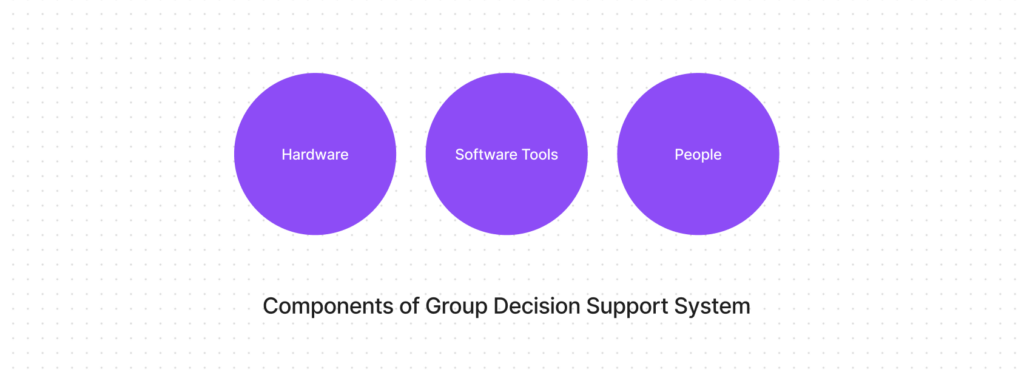Table of Contents
In this article you will learn about Group Decision Support System (GDSS) ,Components Characteristics and also come through its advantages and disadvantages.
What is Group Decision Support System(GDSS)?
A group decision support system (GDSS) is an interactive computer-based system that facilitates a number of decision-makers (working together in a group) in finding solutions to problems that are unstructured in nature. They are designed in such a way that they take input from multiple users interacting simultaneously with the systems to arrive at a decision as a group.
The group decision support system’s tools and procedures help to improve the quality and effectiveness of group meetings. Some group decision-making procedures are supported by groupware and web-based technologies for electronic meetings and videoconferencing, although their primary function is to allow communication between decision-makers.
Each participant in a group decision support system (GDSS) electronic conference is given a computer. The computers are linked to one another, as well as to the facilitator’s computer and the file server. At the front of the room, there is a projection screen. This screen can be used by both the facilitator and the participants to project digital text and images.
Various phases of a group decision support system (GDSS) meeting include idea development, discussion, voting, vote counting, and so on. The facilitator is in charge of overseeing and controlling the implementation of these stages. The facilitator is also in charge of the meeting’s utilisation of various software tools.
Components of Group Decision Support System (GDSS)
A group decision support system (GDSS) is composed of 3 main components, namely hardware, software tools, and people.

- Hardware: It includes electronic hardware like the computer, equipment used for networking, electronic display boards and audiovisual equipment. It also includes the conference facility, including the physical set up – the room, the tables, and the chairs – laid out in such a manner that they can support group discussion and teamwork.
- Software Tools: It includes various tools and techniques, such as electronic questionnaires, electronic brainstorming tools, idea organizers, tools for setting priority, policy formation tool, etc. The use of these software tools in a group meeting helps the group decision-makers to plan, organize ideas, gather information, establish priorities, take decisions and document the meeting proceedings. As a result, meetings become more productive.
- People: It compromises the members participating in the meeting, a trained facilitator who helps with the proceedings of the meeting, and an expert staff to support the hardware and software. The GDSS components together provide a favorable environment for carrying out group meetings.
Characteristics of a GDSS
A GDSS has a number of unique characteristics to support a group of participants in their decision-making process:
- Special design to support creative thinking, effective communications and decision-making techniques
- Easy to use so participants from different backgrounds can all participate effectively
- Flexible so it can incorporate the different perspectives and decision-making styles of the different participants
- Automated record keeping for future review and analysis
- Parallel communication to allow multiple participants to contribute simultaneously
Group Decision Support System (GDSS) Software Tools
Group decision support system software tools help the decision-makers in organizing their ideas, gathering required information and setting and ranking priorities. The following are some of these tools:
- Electronic Questionnaire: The information generated using the questionnaires helps the organizers of the meeting to identify the issues that need immediate attention, thereby enabling the organizers to create a meeting plan in advance.
- Electronic Brainstorming Tools: It allows the participants to simultaneously contribute their ideas on the subject matter of the meeting. As the identity of each participant remains secret, individuals participate in the meeting without the fear of criticism.
- Idea Organizer: It helps in bringing together, evaluating and categorizing the ideas that are produced during the brainstorming activity.
- Tools for Setting Priority: It includes a collection of techniques, such as simple voting, ranking in order and some weighted techniques that are used for voting and setting priorities in a group meeting.
- Policy Formation Tool: It provides the necessary support for converting the wordings of policy statements into an agreement.
Advantages of GDSS
- Better decision : Through the GDSS we can take better decisions because the under GDSS the decisions are taken by a group of DSS.
- Solve the problem : GDSS provide solution to unstructured problems. GDSS collects various type of information at various sources.
- Minimize the risk : GDSS allows managers to assess the risks associated with various alternatives. This helps managers to be proactive rather than reactive.
- Collect large amount of information : GDSS collect information at various sources for making decision making. This information minimizes the risk.
- Provide interactive communication : GDSS provide interactive communication.It takes better decision through the interactive communication.
- Improve the decision making process : GDSS improve the decision making process because GDSS is a goal oriented. When the GDSS is designed the goal is considered.
- Make coordination in various activities :In GDSS decision are taken by a group of DSS. The work is divided into different parts then each DSS performs own work. So the coordination is possible.
Disadvantages of GDSS
- Cost :A significant amount of cost may be associated with putting up the infrastructure consisting of the room, network connectivity and the software.
- Security : This risk arises when the facility for setting up GDSS has been rented. There are chances that information gets leaked to the peers by a low level employee.
- Technical Failure : The system must be properly implemented to reduce the risk associated with loss of connectivity and power loss. It is highly dependent on LAN/WAN infrastructure and bandwidth.
- Keyboarding Skills : If the members get frustrated they might participate less.
- Training : There is variation in the learning curve of the user in various situations.